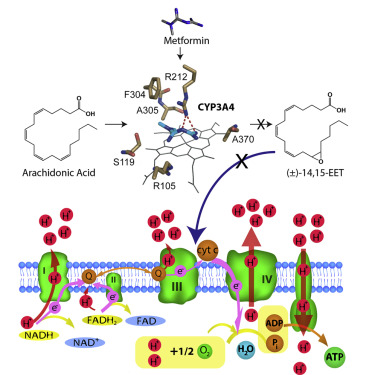当前位置:
X-MOL 学术
›
Cell Chem. Bio.
›
论文详情
Our official English website, www.x-mol.net, welcomes your
feedback! (Note: you will need to create a separate account there.)
Heme Binding Biguanides Target Cytochrome P450-Dependent Cancer Cell Mitochondria
Cell Chemical Biology ( IF 6.6 ) Pub Date : 2017-09-14 00:00:00 , DOI: 10.1016/j.chembiol.2017.08.009 Zhijun Guo , Irina F. Sevrioukova , Ilia G. Denisov , Xia Zhang , Ting-Lan Chiu , Dafydd G. Thomas , Eric A. Hanse , Rebecca A.D. Cuellar , Yelena V. Grinkova , Vanessa Wankhede Langenfeld , Daniel S. Swedien , Justin D. Stamschror , Juan Alvarez , Fernando Luna , Adela Galván , Young Kyung Bae , Julia D. Wulfkuhle , Rosa I. Gallagher , Emanuel F. Petricoin , Beverly Norris , Craig M. Flory , Robert J. Schumacher , M. Gerard O'Sullivan , Qing Cao , Haitao Chu , John D. Lipscomb , William M. Atkins , Kalpna Gupta , Ameeta Kelekar , Ian A. Blair , Jorge H. Capdevila , John R. Falck , Stephen G. Sligar , Thomas L. Poulos , Gunda I. Georg , Elizabeth Ambrose , David A. Potter
Cell Chemical Biology ( IF 6.6 ) Pub Date : 2017-09-14 00:00:00 , DOI: 10.1016/j.chembiol.2017.08.009 Zhijun Guo , Irina F. Sevrioukova , Ilia G. Denisov , Xia Zhang , Ting-Lan Chiu , Dafydd G. Thomas , Eric A. Hanse , Rebecca A.D. Cuellar , Yelena V. Grinkova , Vanessa Wankhede Langenfeld , Daniel S. Swedien , Justin D. Stamschror , Juan Alvarez , Fernando Luna , Adela Galván , Young Kyung Bae , Julia D. Wulfkuhle , Rosa I. Gallagher , Emanuel F. Petricoin , Beverly Norris , Craig M. Flory , Robert J. Schumacher , M. Gerard O'Sullivan , Qing Cao , Haitao Chu , John D. Lipscomb , William M. Atkins , Kalpna Gupta , Ameeta Kelekar , Ian A. Blair , Jorge H. Capdevila , John R. Falck , Stephen G. Sligar , Thomas L. Poulos , Gunda I. Georg , Elizabeth Ambrose , David A. Potter

|
The mechanisms by which cancer cell-intrinsic CYP monooxygenases promote tumor progression are largely unknown. CYP3A4 was unexpectedly associated with breast cancer mitochondria and synthesized arachidonic acid (AA)-derived epoxyeicosatrienoic acids (EETs), which promoted the electron transport chain/respiration and inhibited AMPKα. CYP3A4 knockdown activated AMPKα, promoted autophagy, and prevented mammary tumor formation. The diabetes drug metformin inhibited CYP3A4-mediated EET biosynthesis and depleted cancer cell-intrinsic EETs. Metformin bound to the active-site heme of CYP3A4 in a co-crystal structure, establishing CYP3A4 as a biguanide target. Structure-based design led to discovery of N1-hexyl-N5-benzyl-biguanide (HBB), which bound to the CYP3A4 heme with higher affinity than metformin. HBB potently and specifically inhibited CYP3A4 AA epoxygenase activity. HBB also inhibited growth of established ER+mammary tumors and suppressed intratumoral mTOR. CYP3A4 AA epoxygenase inhibition by biguanides thus demonstrates convergence between eicosanoid activity in mitochondria and biguanide action in cancer, opening a new avenue for cancer drug discovery.
中文翻译:

血红素结合双胍靶向细胞色素P450依赖的癌细胞线粒体
癌细胞固有的CYP单加氧酶促进肿瘤进展的机制尚不清楚。CYP3A4意外地与乳腺癌线粒体相关,并合成了花生四烯酸(AA)衍生的环氧二十碳三烯酸(EETs),从而促进了电子转运链/呼吸作用并抑制了AMPKα。CYP3A4敲低激活AMPKα,促进自噬并防止乳腺肿瘤形成。糖尿病药物二甲双胍抑制CYP3A4介导的EET生物合成,并耗尽癌细胞固有的EET。二甲双胍在共晶体结构中与CYP3A4的活性位血红素结合,从而将CYP3A4确立为双胍靶标。基于结构的设计导致发现N1-己基-N5-苄基-双胍(HBB),其以比二甲双胍更高的亲和力与CYP3A4血红素结合。HBB强烈而特异性地抑制CYP3A4 AA环氧酶的活性。HBB还抑制已建立的ER +乳腺肿瘤的生长,并抑制肿瘤内mTOR。因此,双胍对CYP3A4 AA环氧酶的抑制作用表明线粒体中类二十烷酸活性与癌症中双胍作用之间存在趋同关系,从而为发现癌症药物开辟了新途径。
更新日期:2017-09-15
中文翻译:

血红素结合双胍靶向细胞色素P450依赖的癌细胞线粒体
癌细胞固有的CYP单加氧酶促进肿瘤进展的机制尚不清楚。CYP3A4意外地与乳腺癌线粒体相关,并合成了花生四烯酸(AA)衍生的环氧二十碳三烯酸(EETs),从而促进了电子转运链/呼吸作用并抑制了AMPKα。CYP3A4敲低激活AMPKα,促进自噬并防止乳腺肿瘤形成。糖尿病药物二甲双胍抑制CYP3A4介导的EET生物合成,并耗尽癌细胞固有的EET。二甲双胍在共晶体结构中与CYP3A4的活性位血红素结合,从而将CYP3A4确立为双胍靶标。基于结构的设计导致发现N1-己基-N5-苄基-双胍(HBB),其以比二甲双胍更高的亲和力与CYP3A4血红素结合。HBB强烈而特异性地抑制CYP3A4 AA环氧酶的活性。HBB还抑制已建立的ER +乳腺肿瘤的生长,并抑制肿瘤内mTOR。因此,双胍对CYP3A4 AA环氧酶的抑制作用表明线粒体中类二十烷酸活性与癌症中双胍作用之间存在趋同关系,从而为发现癌症药物开辟了新途径。











































 京公网安备 11010802027423号
京公网安备 11010802027423号